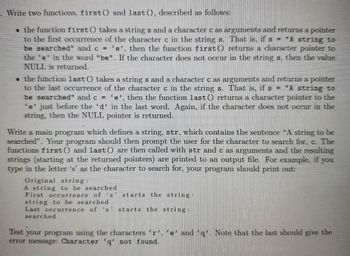
Database System Concepts
7th Edition
ISBN: 9780078022159
Author: Abraham Silberschatz Professor, Henry F. Korth, S. Sudarshan
Publisher: McGraw-Hill Education
expand_more
expand_more
format_list_bulleted
Question
Plz use c programming to complete the coding and plz don't use libraries other than the one written

Transcribed Image Text:Write two functions, first() and last (), described as follows:
• the function first () takes a strings and a character c as arguments and returns a pointer
to the first occurrence of the character c in the string s. That is, if s = "A string to
be searched" and c = 'e', then the function first() returns a character pointer to
the 'e' in the word "be". If the character does not occur in the string s, then the value
NULL is returned.
• the function last () takes a string s and a character c as arguments and returns a pointer
to the last occurrence of the character c in the string s. That is, if s = "A string to
be searched" and c = 'e', then the function last() returns a character pointer to the
'e' just before the 'd' in the last word. Again, if the character does not occur in the
string, then the NULL pointer is returned.
Write a main program which defines a string, str, which contains the sentence “A string to be
searched". Your program should then prompt the user for the character to search for, c. The
functions first() and last () are then called with str and c as arguments and the resulting
strings (starting at the returned pointers) are printed to an output file. For example, if you
type in the letter 's' as the character to search for, your program should print out:
Original string :
A string to be searched
First occurrence of 's' starts the string:
string to be searched
Last occurrence of 's' starts the string :
searched
Test your program using the characters 'r', 'e' and 'q'. Note that the last should give the
error message: Character 'q' not found.
![#include<stdio.h>
char* first (char* s, char c);
int main(void) {
char* f
char* i;
}
f=first(s,c);
if (f==NULL) {
}else{
fprintf(fout, "%s", f);
}
return 0;
}
char first (char* s, char c) {
char* answer=NULL;
for (i-e;s[i]!= '\0';i++){
if(s[i]==c){
answer=&s[i];
break;
return answer;](https://content.bartleby.com/qna-images/question/88f9be6d-d8dd-4674-ab78-d1dd0cdba8bb/bde044ff-a734-442f-a59f-c3471fdde644/1bwk5a_thumbnail.jpeg)
Transcribed Image Text:#include<stdio.h>
char* first (char* s, char c);
int main(void) {
char* f
char* i;
}
f=first(s,c);
if (f==NULL) {
}else{
fprintf(fout, "%s", f);
}
return 0;
}
char first (char* s, char c) {
char* answer=NULL;
for (i-e;s[i]!= '\0';i++){
if(s[i]==c){
answer=&s[i];
break;
return answer;
Expert Solution
This question has been solved!
Explore an expertly crafted, step-by-step solution for a thorough understanding of key concepts.
Step by stepSolved in 2 steps with 2 images

Knowledge Booster
Learn more about
Need a deep-dive on the concept behind this application? Look no further. Learn more about this topic, computer-science and related others by exploring similar questions and additional content below.Similar questions
- WAP in C++ for the converter to input the string from console and convert all characters to uppercase.arrow_forwardHow might this be accomplished? What advantages may the C calling convention offer over the STDCALL calling convention?arrow_forwardWhat are some of the benefits and drawbacks associated with using decimal data types?arrow_forward
arrow_back_ios
arrow_forward_ios
Recommended textbooks for you
 Database System ConceptsComputer ScienceISBN:9780078022159Author:Abraham Silberschatz Professor, Henry F. Korth, S. SudarshanPublisher:McGraw-Hill Education
Database System ConceptsComputer ScienceISBN:9780078022159Author:Abraham Silberschatz Professor, Henry F. Korth, S. SudarshanPublisher:McGraw-Hill Education Starting Out with Python (4th Edition)Computer ScienceISBN:9780134444321Author:Tony GaddisPublisher:PEARSON
Starting Out with Python (4th Edition)Computer ScienceISBN:9780134444321Author:Tony GaddisPublisher:PEARSON Digital Fundamentals (11th Edition)Computer ScienceISBN:9780132737968Author:Thomas L. FloydPublisher:PEARSON
Digital Fundamentals (11th Edition)Computer ScienceISBN:9780132737968Author:Thomas L. FloydPublisher:PEARSON C How to Program (8th Edition)Computer ScienceISBN:9780133976892Author:Paul J. Deitel, Harvey DeitelPublisher:PEARSON
C How to Program (8th Edition)Computer ScienceISBN:9780133976892Author:Paul J. Deitel, Harvey DeitelPublisher:PEARSON Database Systems: Design, Implementation, & Manag...Computer ScienceISBN:9781337627900Author:Carlos Coronel, Steven MorrisPublisher:Cengage Learning
Database Systems: Design, Implementation, & Manag...Computer ScienceISBN:9781337627900Author:Carlos Coronel, Steven MorrisPublisher:Cengage Learning Programmable Logic ControllersComputer ScienceISBN:9780073373843Author:Frank D. PetruzellaPublisher:McGraw-Hill Education
Programmable Logic ControllersComputer ScienceISBN:9780073373843Author:Frank D. PetruzellaPublisher:McGraw-Hill Education

Database System Concepts
Computer Science
ISBN:9780078022159
Author:Abraham Silberschatz Professor, Henry F. Korth, S. Sudarshan
Publisher:McGraw-Hill Education

Starting Out with Python (4th Edition)
Computer Science
ISBN:9780134444321
Author:Tony Gaddis
Publisher:PEARSON

Digital Fundamentals (11th Edition)
Computer Science
ISBN:9780132737968
Author:Thomas L. Floyd
Publisher:PEARSON

C How to Program (8th Edition)
Computer Science
ISBN:9780133976892
Author:Paul J. Deitel, Harvey Deitel
Publisher:PEARSON

Database Systems: Design, Implementation, & Manag...
Computer Science
ISBN:9781337627900
Author:Carlos Coronel, Steven Morris
Publisher:Cengage Learning

Programmable Logic Controllers
Computer Science
ISBN:9780073373843
Author:Frank D. Petruzella
Publisher:McGraw-Hill Education